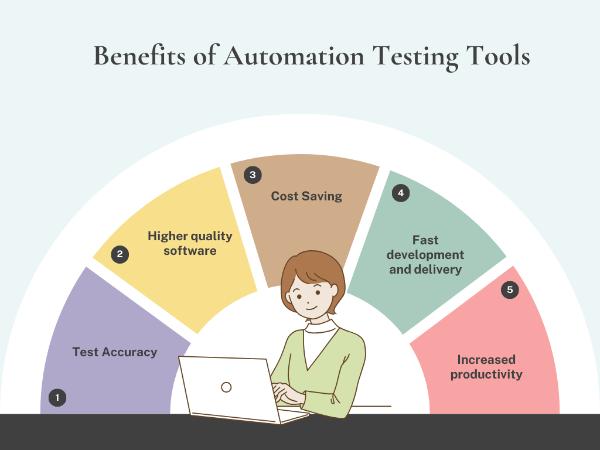In today’s fast-paced software development environment, automation testing tools are essential for ensuring speed and accuracy. These tools streamline the testing process by automating repetitive tasks, reducing manual effort, and increasing precision. They enable the rapid development of robust, reliable software with fewer defects. These tools are indispensable in modern development, helping teams maintain a competitive edge by delivering high-quality products faster.
What Are Automation Testing Tools?
Automation testing tools are designed to execute predefined sets of tests on an application to compare actual results with expected outcomes. This significantly accelerates the testing process. By reducing the need for manual intervention, automation enhances the accuracy of software validation. For more details on these tools, check out what are automation tools.
Benefits of Automation Testing Tools
High Efficiency
Automation testing tools largely accelerate the testing process by providing the capability of performing many test cases simultaneously, which speeds up testing by 70% and reduces the time required for software products to reach the market.
More Comprehensive Test Coverage
These tools extend test coverage by 50% or more, covering all possible scenarios and edge cases that manual testing might miss, thereby improving software robustness and reliability.
Cost Saving
Automation tools require an initial investment, which may not be cheap, but they pay off in the long run with significant savings—up to an 80% reduction in testing costs through increased efficiency and reduced manual effort and rework.

Higher Accuracy and Reliability:
Automation significantly reduces human error, leading to higher accuracy in defect detection and increasing test reliability by up to 50%.
This is very important for detecting periodic problems and maintaining the quality of software.
Scalability and Flexibility:
Automation tools excel at handling increasing complexities and large volumes of test cases.
This scalability supports growing project demands without requiring a proportionate increase in resources, allowing them to adapt to evolving requirements.
The Power of Efficiency: Maximizing Testing Through Automation
Streamlined Test Execution
Imagine running hundreds of complex tests simultaneously, effortlessly. That’s the reality with automation testing tools. These powerhouses can accelerate testing by up to 70%, allowing teams to execute numerous test cases concurrently. The result? A dramatically reduced time-to-market for software products.
Enhanced Test Coverage
But speed isn’t everything. What about thoroughness? Automated testing shines here too, increasing test coverage by 50% or more.
This means exploring a wider array of scenarios and edge cases that manual testing might miss, ensuring your software is robust and reliable.
Consistent and Reliable Results
Consistency is key in testing, and automation delivers in spades. By consistently executing tests, these tools reduce variability and enhance reliability.
This consistency can lead to a decrease in defect escape rates by as much as 30%, catching more bugs before they reach your users.
The Bottom Line: Cost-effectiveness and ROI
Long-Term Cost Reduction
While the initial investment in automation tools might seem steep, the long-term savings are substantial.
Companies implementing automation testing can save up to 80% in testing costs over time. How? By minimizing the need for extensive manual testing and reducing costly rework.
Accelerated Time-to-Market
In the competitive software market, speed is often a decisive factor. Automation can slash testing time by half, enabling quicker product releases.
This rapid turnaround is more than just efficiency; it’s a competitive edge that allows businesses to respond swiftly to market demands.
Scalability That Grows With You
As your projects grow in complexity, so do your testing needs. Automation tools excel here, handling thousands of test cases simultaneously without a proportional increase in resources.
This scalability ensures that your testing keeps pace with your ambitions.
Precision and Risk Mitigation: The Accuracy Advantage
Minimized Human Error
Human testers are valuable, but they’re not infallible. Automation testing can reduce human error by up to ninety percent, ensuring higher accuracy in defect detection. This precision directly enhances software quality.
Increased Test Reliability
Automated tests can be run repeatedly without performance degradation. This consistency is crucial for identifying those tricky, intermittent issues that manual testing might miss. The result? Improved reliability by up to half.
Proactive Risk Management
By implementing automated testing early in the development cycle, teams can identify up to seventy percent of potential risks and vulnerabilities before they escalate into costly problems.
This proactive approach to risk management can save time, money, and protect reputations.
Comparison: Manual vs. Automated Testing
| Aspect | Manual Testing | Automated Testing |
| Speed | Slower, limited by human capacity | Up to 70% faster execution |
| Accuracy | Prone to human error | Reduces errors by up to 90% |
| Cost | Higher long-term costs | Up to 80% cost savings over time |
| Scalability | Limited by human resources | Easily scales to thousands of tests |
| Consistency | Variable results | Highly consistent outcomes |
| Coverage | Limited scenario testing | Up to 50% increase in test coverage |
FAQs
- What types of testing can be automated?
Automation tools are versatile, effectively managing functional, regression, performance, and load testing. They adapt to diverse project needs, enhancing overall testing efficiency across various scenarios.
- How do I choose the right automation testing tool for my project?
Selecting the right tool involves assessing compatibility with your technology stack, integration capabilities, and how well it meets your specific testing requirements. This strategic choice can significantly impact your testing efficiency and effectiveness.
- What are the common challenges associated with automation testing?
Key challenges include initial implementation costs, the need for skilled personnel to develop and maintain test scripts, and potential compatibility issues. These challenges can be addressed through strategic planning, investment in training, and selecting tools that align with your project needs.
Conclusion
Automation testing tools are not just a trend; they’re a fundamental shift in how we approach software quality assurance.
By dramatically improving efficiency, accuracy, and cost-effectiveness, these tools enable development teams to deliver higher-quality software faster than ever before.
As the software landscape evolves, embracing automation testing isn’t just an option; it’s a necessity for staying competitive.
The benefits are clear: faster releases, higher quality, and more efficient resource use..
Are you ready to revolutionize your testing process? The future of software development is automated, and the time to adapt is now.































